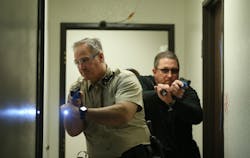We all do it—run toward gunfire rather than away from it. Why? Well it’s hard to explain but when you’re a cop, it’s simply innate, something in our DNA. We know someone is likely in trouble and the quicker we get there, the better. But in our haste to rescue someone, we put ourselves at risk of being shot. Does that mean we shouldn’t run toward danger? NO.
We know when an active shooter call goes out our adrenaline begins to pump and we punch the accelerator through the floorboard knowing every second counts. Once on the scene, we bail out of the car, hopefully, rifle or shotgun in hand, and run toward the gunfire. We all do it, myself included. However, is there a safer way to respond? YES.
As difficult as it seems, we must train ourselves to remember and utilize tactics. We can still move quickly, but approach tactically. If we’re fortunate to have several officers on scene, voice coordination of movement is the prudent choice to make. A quick perusal of available cover and/or concealment is a must. Then a leapfrog advancement of cover and movement gives us a better chance of safely gaining control.
Not knowing all the specifics of the unfolding incident, consider more than one shooter may be involved. If the manpower is available, flanks and rear need covering. More and more of these modern day active shooters have military experience and hope the cops will disregard their tactics. Don’t fall into a trap.
If you’re alone, you can still advance tactically using the same skills. Look for cover and move from one spot to the next while checking flanks and rear. In the case of an open area with no available cover, your car may be the only available cover you have. Use it wisely, knowing rounds can hit their intended target through glass and doors, particularly, rifle rounds.
Should the venue be one where large crowds have assembled, be mindful of those running to escape. A shooter can easily camouflage himself as one of those fleeing, and attack you from behind. If possible, stop one of those running for the exits for a quick description of the shooter or shooters. Then quickly relay that info to dispatch. Information is key in these high-risk quick developing scenarios.
Remember 360 degree scanning is your best choice. Stop, look, listen. Look up, look down, look all around. No active shooter situations are identical. Some shooters will try to engage you immediately, while others will hide themselves and lie in wait. The real cowards will kill themselves (best outcome). Regardless, it’s your job to minimize injuries and fatalities, and at the same time relay information to your colleagues.
This article is simply a reminder of what most of you already know. You should be thinking about the what if’s—what do I do if “A” or “B” happens. Think of all the outcomes and all of your options to address them. Having a plan is key to a quick response, one that may save your life.
Stay Safe, Brothers and Sisters.
About the Author
John Wills
John M. Wills is a former Chicago police officer and retired FBI agent. He is a freelance writer and award-winning author in a variety of genres, including novels, short stories and poetry. John also writes book reviews for the New York Journal of Books, and is a member of the National Book Critics Circle. His new book, The Year Without Christmas, is available now. Visit John at: www.johnmwills.com.

